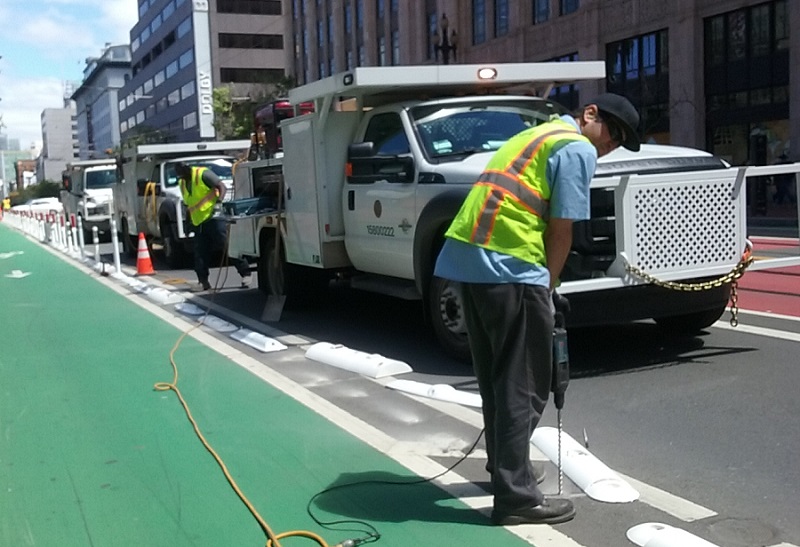In a new experiment on Market Street, we’ve installed four types of safe-hit posts along a block of bike lane.
Plastic “safe-hit” posts may be a relatively quick and low-cost way to separate bike lanes from traffic lanes, but to do their job, they need to last.
This week, we started a new experiment to identify the most durable safe-hit post design by installing four different types of them along a block of Market Street, westbound from 9th to 10th Street. It’s part of our efforts to adopt and improve upon the best practices for building effective protected bike lanes.
Safe-hit posts are installed along bike lanes to deter drivers from entering them illegally. Thanks to their flexible material, they still allow emergency and paratransit vehicles to pass over them without causing damage (and ideally, they stay standing).
But in many cases, the types of safe-hit posts installed in SF and other cities in past years have continued to be run over illegally and need to be replaced regularly. Those installations only consisted of vertical posts applied to the pavement with epoxy.
More than a year ago, we switched to new types of safe-hit posts that are drilled into the ground and feature a raised plastic curb at their base. Those are more durable and effective at deterring drivers from running over them in the first place.

SFMTA crews drilling in the new safe-hit posts on Market.
In recent months, you may have spotted these new posts with curb bases at:
- 9th and Division streets, as part of a protected intersection upgrade
- 17th Street, between Kansas Street and Potrero Avenue
- Folsom Street, between 4th and 5th streets
- Polk Street, southbound between Hayes and Market streets
We’ve had generally positive results with the curb-base posts we’ve installed at these locations, but we’ve used a few different variations of them, and it's not yet clear which one can endure the most abuse. By testing out a mix of post types on Market, our goal is to drill down on the best one to apply consistently.
People biking by the new mix of safe-hit posts on Market.
It’s important to get these kinds of details right as we upgrade and grow our network of protected bike lanes to be safer and more comfortable for everyone (and pave the way for other cities to do so).
Market Street, known as the busiest bicycling street west of the Mississippi, serves as a great petri dish for us to conduct this kind of research. Last year, we studied four different types of raised bikeway designs on Market, between 12th and Gough streets. We found that on busy commercial streets, safe-hit posts are more effective than raised bikeways at deterring illegal parking and loading (unless the bike lane has a parking-protected configuration). In light of those findings, we changed our plans for a raised bikeway on Polk Street, which will now be built at road level with safe-hit posts instead.
Comments are for the English version of this page.